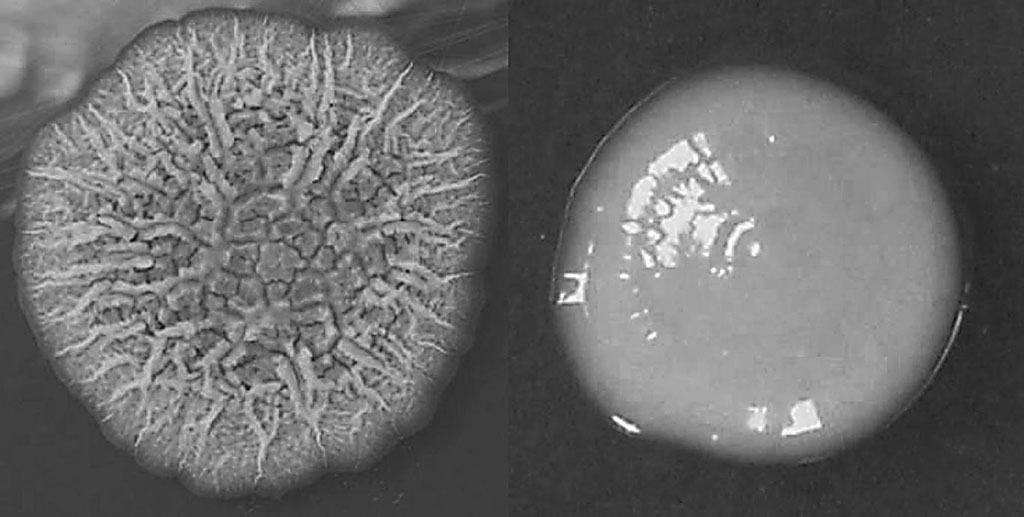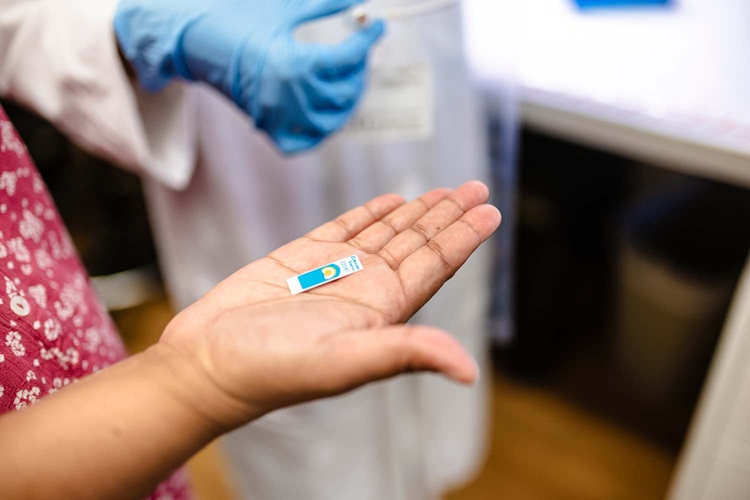Mycobacterium Infection Found in Gastric Patients’ Stomachs
|
By LabMedica International staff writers Posted on 26 Nov 2019 |

Image: Growth characteristics of rough and smooth phenotypes of Mycobacterium abscessus on 7H11 agar cultured at 37 °C: representative single rough (left) and smooth (right) colonies (Photo courtesy of Hannover Medical School)
Development of gastric diseases such as gastritis, peptic ulcer and gastric cancer is often associated with several biotic and abiotic factors. Helicobacter pylori infection is such a well-known biotic factor. However, not all H. pylori-infected individuals develop gastric diseases and not all individuals with gastric diseases are infected with H. pylori.
H. pylori is not the only bacterium that can colonize human stomach. Culture independent metagenomic sequence analyses have shown that human stomach carries a unique microbiota. The dominant phyla that are present in human stomach are Proteobacteria, Firmicutes, Actinobacteria and Fusobacterium. Interestingly, however, most of these bacteria cannot be cultured using traditional techniques.
Microbiologists at the Rajiv Gandhi Centre for Biotechnology (Thiruvananthapuram, India) recruited patients aged between 20 and 70 with various gastric and esophageal symptoms ranging from mild dyspepsia, gastro-esophageal reflux disorder to severe gastric diseases like gastric cancer and who were recommended to have upper gastrointestinal endoscopy. Three gastric biopsy specimens were collected from each patient for this study. The aim of this study was to isolate prevalent gastric bacteria under microaerobic condition and identify them by 16S rRNA gene sequence analysis.
The team employed various technologies including gastric bacteria culture, bacterial DNA isolation, extraction of intracellular bacterial DNA from biopsy tissues, molecular characterization of the bacteria isolated from stomach. The purified DNA fragments were sequenced by a 3730XL DNA analyzer (Thermo Fisher Scientific, Waltham, Massachusetts, USA). The team also performed Hematoxylin and Eosin (H&E) and Ziehl-Neelsen Acid-fast staining on tissue biopsies, and immunohistochemistry.
Analysis of gastric biopsies showed infection of Mycobacterium abscessus (phylum Actinobacteria) to be highly prevalent in the stomachs of subjects included. The data showed that of 129 (67 male and 62 female) patients with gastric symptoms, 96 (51 male and 45 female) showed the presence of M. abscessus in stomach tissues. Infection of M. abscessus in gastric epithelium was further confirmed by imaging with acid fast staining, immunohistochemistry and immunofluorescence. Surprisingly, the subjects studied, the prevalence of M. abscessus infection in stomach is even higher than the prevalence of H. pylori infection.
The authors concluded that their study on 129 individuals with gastric diseases shows that the prevalence of gastric M. abscessus is higher in the local population as compared to the prevalence of H. pylori. The route of transmission is not known at present, but water could be a source. Significance of this infection is also presently unknown, but it may have a significant role in the formation or progression of gastric disease. The study was published on November 4, 2019 in the journal PLOS Neglected Tropical Diseases.
Related Links:
Rajiv Gandhi Centre for Biotechnology
Thermo Fisher Scientific
H. pylori is not the only bacterium that can colonize human stomach. Culture independent metagenomic sequence analyses have shown that human stomach carries a unique microbiota. The dominant phyla that are present in human stomach are Proteobacteria, Firmicutes, Actinobacteria and Fusobacterium. Interestingly, however, most of these bacteria cannot be cultured using traditional techniques.
Microbiologists at the Rajiv Gandhi Centre for Biotechnology (Thiruvananthapuram, India) recruited patients aged between 20 and 70 with various gastric and esophageal symptoms ranging from mild dyspepsia, gastro-esophageal reflux disorder to severe gastric diseases like gastric cancer and who were recommended to have upper gastrointestinal endoscopy. Three gastric biopsy specimens were collected from each patient for this study. The aim of this study was to isolate prevalent gastric bacteria under microaerobic condition and identify them by 16S rRNA gene sequence analysis.
The team employed various technologies including gastric bacteria culture, bacterial DNA isolation, extraction of intracellular bacterial DNA from biopsy tissues, molecular characterization of the bacteria isolated from stomach. The purified DNA fragments were sequenced by a 3730XL DNA analyzer (Thermo Fisher Scientific, Waltham, Massachusetts, USA). The team also performed Hematoxylin and Eosin (H&E) and Ziehl-Neelsen Acid-fast staining on tissue biopsies, and immunohistochemistry.
Analysis of gastric biopsies showed infection of Mycobacterium abscessus (phylum Actinobacteria) to be highly prevalent in the stomachs of subjects included. The data showed that of 129 (67 male and 62 female) patients with gastric symptoms, 96 (51 male and 45 female) showed the presence of M. abscessus in stomach tissues. Infection of M. abscessus in gastric epithelium was further confirmed by imaging with acid fast staining, immunohistochemistry and immunofluorescence. Surprisingly, the subjects studied, the prevalence of M. abscessus infection in stomach is even higher than the prevalence of H. pylori infection.
The authors concluded that their study on 129 individuals with gastric diseases shows that the prevalence of gastric M. abscessus is higher in the local population as compared to the prevalence of H. pylori. The route of transmission is not known at present, but water could be a source. Significance of this infection is also presently unknown, but it may have a significant role in the formation or progression of gastric disease. The study was published on November 4, 2019 in the journal PLOS Neglected Tropical Diseases.
Related Links:
Rajiv Gandhi Centre for Biotechnology
Thermo Fisher Scientific
Latest Molecular Diagnostics News
- STI Molecular Test Delivers Rapid POC Results for Treatment Guidance
- Blood Biomarker Improves Early Brain Injury Prognosis After Cardiac Arrest
- Biomarkers Could Identify Patients at High Risk of Severe AKI After Major Surgery
- CLIA Test Identifies Head and Neck Cancer Recurrence from Post-Surgical Lymphatic Fluid
- New 15-Minute Hepatitis C Test Paves Way for Same-Day Treatment
- Ovarian Cancer Assay Outperforms Traditional Tests in Early Detection
- Ultrasensitive Method Detects Low-Frequency Cancer Mutations
- Blood Test Enables Non-Invasive Endometriosis Detection
- New Blood Biomarkers Help Diagnose Pregnancy-Linked Liver Complication
- Simple Urine Test to Revolutionize Bladder Cancer Diagnosis and Treatment
- Blood Test to Enable Earlier and Simpler Detection of Liver Fibrosis
- Genetic Marker to Help Children with T-Cell Leukemia Avoid Unnecessary Chemotherapy
- Four-Gene Blood Test Rules Out Bacterial Lung Infection
- New PCR Test Improves Diagnostic Accuracy of Bacterial Vaginosis and Candida Vaginitis
- New Serum Marker-Editing Strategy to Improve Diagnosis of Neurological Diseases
- World’s First Genetic Type 1 Diabetes Risk Test Enables Early Detection
Channels
Clinical Chemistry
view channel
POC Breath Diagnostic System to Detect Pneumonia-Causing Pathogens
Pseudomonas aeruginosa is a major cause of hospital-acquired and ventilator-associated pneumonia, particularly in lung transplant recipients and patients with structural lung disease. Its ability to form... Read more
Online Tool Detects Drug Exposure Directly from Patient Samples
Doctors often rely on patient interviews and medical records to determine what medications a person has taken, but this information is frequently incomplete. People may forget drugs they used, take over-the-counter... Read moreMolecular Diagnostics
view channel
STI Molecular Test Delivers Rapid POC Results for Treatment Guidance
An affordable, rapid molecular diagnostic for sexually transmitted infections (STIs) has the potential to be globally relevant, particularly in resource-limited settings where rapid, point-of-care results... Read more
Blood Biomarker Improves Early Brain Injury Prognosis After Cardiac Arrest
After a cardiac arrest, many patients remain unconscious for days, leaving doctors and families facing uncertainty about whether meaningful recovery is possible. Current tools to assess brain damage, including... Read more
Biomarkers Could Identify Patients at High Risk of Severe AKI After Major Surgery
Acute kidney injury is one of the most common and dangerous complications after major surgery, particularly among patients in intensive care. Even mild impairment of kidney function can lead to long-term... Read more
CLIA Test Identifies Head and Neck Cancer Recurrence from Post-Surgical Lymphatic Fluid
While the lymphatic system’s critical role in metastasis has long been recognized, routine access to patient lymph has been elusive. Now, a non-invasive process can access lymph through the collection... Read moreHematology
view channel
MRD Tests Could Predict Survival in Leukemia Patients
Acute myeloid leukemia is an aggressive blood cancer that disrupts normal blood cell production and often relapses even after intensive treatment. Clinicians currently lack early, reliable markers to predict... Read more
Platelet Activity Blood Test in Middle Age Could Identify Early Alzheimer’s Risk
Early detection of Alzheimer’s disease remains one of the biggest unmet needs in neurology, particularly because the biological changes underlying the disorder begin decades before memory symptoms appear.... Read more
Microvesicles Measurement Could Detect Vascular Injury in Sickle Cell Disease Patients
Assessing disease severity in sickle cell disease (SCD) remains challenging, especially when trying to predict hemolysis, vascular injury, and risk of complications such as vaso-occlusive crises.... Read more
ADLM’s New Coagulation Testing Guidance to Improve Care for Patients on Blood Thinners
Direct oral anticoagulants (DOACs) are one of the most common types of blood thinners. Patients take them to prevent a host of complications that could arise from blood clotting, including stroke, deep... Read moreImmunology
view channel
Blood Test Could Identify Colon Cancer Patients to Benefit from NSAIDs
Colon cancer remains a major cause of cancer-related illness, with many patients facing relapse even after surgery and chemotherapy. Up to 40% of people with stage III disease experience recurrence, highlighting... Read moreBlood Test Could Detect Adverse Immunotherapy Effects
Immune checkpoint inhibitors have transformed cancer treatment, but they can also trigger serious immune-related adverse events that damage healthy organs and may become life-threatening if not detected early.... Read morePathology
view channel
Rapid Low-Cost Tests Can Prevent Child Deaths from Contaminated Medicinal Syrups
Medicinal syrups contaminated with toxic chemicals have caused the deaths of hundreds of children worldwide, exposing a critical gap in how these products are tested before reaching patients.... Read more
Tumor Signals in Saliva and Blood Enable Non-Invasive Monitoring of Head and Neck Cancer
Head and neck cancers are among the most aggressive malignancies worldwide, with nearly 900,000 new cases diagnosed each year. Monitoring these cancers for recurrence or relapse typically relies on tissue... Read more
Common Health Issues Can Influence New Blood Tests for Alzheimer’s Disease
Blood-based tests for Alzheimer’s disease are transforming diagnosis by offering a simpler alternative to spinal taps and brain imaging. However, many people evaluated at memory clinics also live with... Read more
Blood Test Formula Identifies Chronic Liver Disease Patients with Higher Cancer Risk
Chronic liver disease affects millions worldwide and can progress silently to hepatocellular carcinoma (HCC), one of the deadliest cancers globally. While surveillance guidelines exist for patients with... Read moreTechnology
view channel
Machine Learning Models Diagnose ALS Earlier Through Blood Biomarkers
Amyotrophic lateral sclerosis (ALS) is a rapidly progressive neurodegenerative disease that is notoriously difficult to diagnose in its early stages. Early symptoms often overlap with other neurological... Read more
Artificial Intelligence Model Could Accelerate Rare Disease Diagnosis
Identifying which genetic variants actually cause disease remains one of the biggest challenges in genomic medicine. Each person carries tens of thousands of DNA changes, yet only a few meaningfully alter... Read moreIndustry
view channel
BD and Penn Institute Collaborate to Advance Immunotherapy through Flow Cytometry
BD (Becton, Dickinson and Company, Franklin Lakes, NJ, USA) has entered into a strategic collaboration with the Institute for Immunology and Immune Health (I3H, Philadelphia, PA, USA) at the University... Read more



















